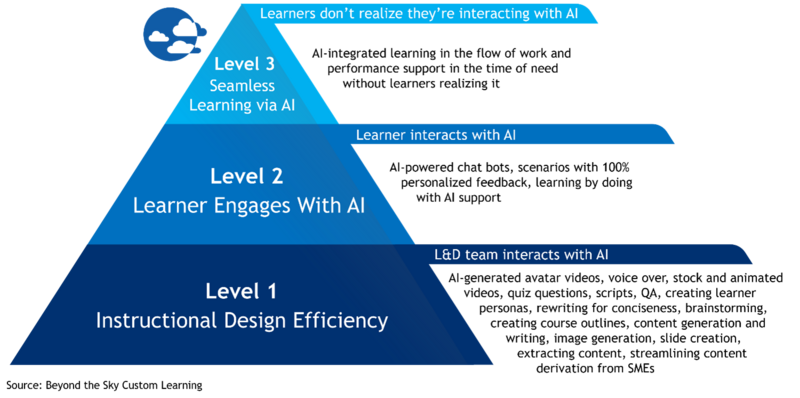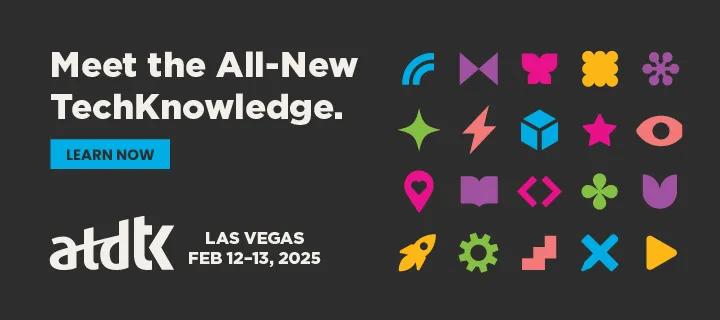ATD Blog
10 Immediate Uses for AI in Talent Development
Let's explore 10 applications of AI in TD, demonstrating how Level 1 and Level 2 tools can drive meaningful improvements in efficiency, personalization, and scalability.
Wed Nov 13 2024

Since it has become more mainstream, generative AI is rapidly transforming the way we approach talent development (TD). What was once a manual, time-intensive process is now being streamlined with powerful AI tools that are transforming how we strategize, design, and analyze learning experiences. While AI can feel overwhelming, it brings tangible benefits to our daily work. From automating repetitive tasks to delivering personalized learning at scale, AI is opening new possibilities to enhance both efficiency and effectiveness.
Typically, TD professionals use AI in three levels for learning solutions. Level 1 focuses on supporting TD professionals in their current tasks with increased efficiency. Learners interact directly with AI for personalized feedback in Level 2. In Level 3, AI is seamlessly integrated into the workflow, providing unobtrusive, real-time support. This article explores 10 immediate applications of AI in TD, demonstrating how even Level 1 and Level 2 tools can drive meaningful improvements in efficiency, personalization, and scalability.

1. Generate Course Outlines and Content
One of the easiest ways to leverage generative AI is by using it to draft course outlines. By inputting high-level learning goals or objectives, large language models (LLMs) like ChatGPT, Gemini, Claude, or Copilot can generate detailed outlines, suggesting the sequence and structure of lessons. This significantly accelerates the content development phase, allowing instructional designers to focus on refining material instead of building from scratch.
In addition, generative AI can create foundational content for training materials. By uploading relevant files (with proper permissions) or using generic content sourced by AI, we can then edit, add to, and tailor the AI-generated content to meet specific organizational needs, reducing development time while keeping a human in the loop to ensure quality.
2. Create AI-Generated Videos and Voice-Overs
Another easy and effective way to start using generative AI is by leveraging it for video and voice-over creation. Video production has traditionally been resource-intensive, but with generative AI, creating engaging videos is now much simpler. AI-generated avatars, stock videos, and animated sequences can deliver messages using text-to-speech and prompt-to-video technology. This speeds up the creation process, eliminating the need for filming, voice talent, or costly post-production editing. For example, this AI-generated video trailer was created using various AI tools, with text prompts to generate the scenes, background music, and images.
Beyond video, generative AI can enhance other learning formats, such as podcasts and e-learning, by providing high-quality voice-overs. AI voice technology enables the creation of professional-sounding narration in multiple languages, making learning accessible to a diverse audience. Imagine producing a podcast in several languages using AI, even if the original speakers only speak one language.
Additionally, AI avatars and voice-over tools allow for easier updates when training content changes, requiring only text-to-speech revisions rather than re-shooting or re-recording. For example, my team used AI avatar creation tools to craft character-rich stories combined with AI-driven stock videos. When policies changed, it was easy to update the video to reflect the new content.
3. Image and Sound Effect Generation
Creating visuals and audio elements for learning solutions can be a tedious process, especially when the right resources aren’t readily available in stock libraries. Generative AI tools can create unique images, sound effects, and music that match the training’s mood and objectives.
For example, we once needed background music for an e-learning module that set the right tone but couldn’t find anything suitable in stock libraries. Using AI, we generated music tailored to the specific atmosphere we wanted to create. We used the same approach for sound effects, which we could easily generate to fit course interactions.
Similarly, when we needed images of specific work scenarios, such as Inuit people in professional settings, generative AI allowed us to create these visuals when stock images fell short. These tools not only save time but also help you create learning solutions that are instructionally sound and accurate.
4. Streamline Content Derivation From SMEs
Extracting knowledge from subject matter experts (SMEs) is often complex and time-consuming. AI simplifies this by transcribing SME interviews and summarizing key points, significantly reducing the time needed to convert SME insights into actionable training content.
For example, with proper permissions and in line with corporate policy, I used AI tools after an SME interview to capture critical insights and format them into concise, readable summaries. This eliminated the need for manual transcription and note-taking, ensuring valuable SME knowledge was captured accurately. Additionally, generative AI can summarize other SME-provided content, such as manuals or policies.
5. Adapt for Different Writing Styles
Instructional content often needs to be tailored to the audience and context. Generative AI is particularly useful for transforming or blending materials to match specific tones, styles, or formats—whether that means making language more formal, casual, concise, or cohesive. This flexibility enables quick adjustment to content to meet specific requirements.
For example, I once asked a team member to write a script for a sales video, a style unfamiliar to him. With the help of generative AI, he produced a polished, persuasive script that captured the desired tone almost instantly. Similarly, when he needed to convert highly technical training content into plain language, he used AI to simplify jargon-heavy material while preserving the core message. This approach ensured learners could easily grasp complex topics, making the training more effective.
6. Generate Quiz Questions and Assessments
Another practical use for generative AI is creating quiz questions and assessments. Applying AI to course content with tailored prompts generates questions at varying difficulty levels, supporting a well-rounded evaluation strategy.
For example, AI can quickly generate comprehension questions, allowing instructional designers to focus more on content quality and accuracy. Although these questions should be reviewed for precision, AI significantly reduces the manual effort associated with quiz creation.
7. Extract, Summarize, and Visualize Learning Data
AI excels at processing and summarizing large volumes of data, making it an invaluable tool for analyzing learner feedback and evaluating training effectiveness. After a training session, AI can be used to analyze multiple data sources—such as feedback forms, quiz results, and participation data—to uncover trends and areas needing improvement. Additionally, AI can identify patterns in quiz performance, highlighting topics that may require more emphasis in future course iterations.
Beyond measuring effectiveness, AI can help create learner personas fueled by AI-synthesized data, leveraging qualitative data from focus groups, quantitative survey results, and patterns within learning management system (LMS) data. This comprehensive analysis gives us a clearer understanding of our learners, enabling them to develop more effective learning solutions.
To enhance insights further, AI tools can generate graphs, charts, and other visual representations, making it easier to identify trends and communicate findings. For example, I use AI to create visualizations of my team’s performance, helping me quickly identify specific gaps. This, combined with the ability to query AI for insights within the data, supports my data-driven decision making.
8. Personalized Learner Interactions at Scale
Moving beyond Level 1 applications that improve efficiency in tasks we already perform, we can explore Level 2 interactions that deliver solutions previously impossible without AI. For example, by integrating generative AI directly into e-learning environments, learners can receive 100 percent personalized feedback at scale. Instead of traditional e-learning scenarios with multiple-choice questions or static interactions, AI enables learners to provide free-form responses and receive dynamic, real-time feedback tailored to their specific input.
Learners, for instance, can practice difficult conversations through AI-driven simulations, receiving personalized guidance based on their unique responses in a scalable and more effective way. This deeper level of personalized interaction not only increases engagement but also ensures that learners receive relevant, meaningful feedback to enhance their skills.
9. Specific Learner Solutions at Their Fingertips
Other Level 2 interactions allow learners to engage directly with a large language model (LLM) to get accurate, specific answers tailored to their learning needs. By creating an internal knowledge repository accessed through a secure LLM, learners can easily obtain customized responses to individual questions.
Think of it as an enhanced FAQ system—rather than directing learners to webpages or documents, the AI tool delivers precise answers based on the query. For instance, my team developed an internal content repository of our processes, enabling team members to ask specific questions, such as, “What should I consider for PDF accessibility before design, and who checks it?” and receive detailed responses outlining the steps and responsible roles. This approach eliminates the common issue of people overlooking policy files or documentation by providing direct, tailored answers as needed.
10. Have Your Personal AI Coach
One of the most valuable applications of generative AI is as a personal coach, offering tailored advice, feedback, and brainstorming support. Whether you’re seeking ideas or guidance on personal or professional challenges, AI can serve as a powerful resource, promoting creative brainstorming sessions that reveal fresh perspectives and uncover solutions you might not have considered.
For example, I quickly created a free custom GPT to act as my personal communication coach to refine the tone of emotionally charged messages. When drafting messages, I would write what I truly wanted to say, and the GPT would polish it, ensuring the tone remained professional and free from unnecessary emotion. This allowed me to express myself freely, while the AI coach helped keep my communication polished and professional. Additionally, I asked the custom GPT to identify common areas for improvement, providing me with objective feedback in real time.
Beyond communication, AI also serves as an effective brainstorming partner, offering fresh ideas and solutions for challenges like navigating difficult decisions or conversations. I frequently use ChatGPT as a coach to help me objectively analyze situations, providing data-driven insights that lead to more informed decisions. By providing relevant context—such as information about my work environment or family dynamics—AI can offer even more personalized advice, becoming a trusted sounding board for important decisions. Ultimately, AI-driven coaching enhances your ability to brainstorm, communicate, and problem-solve more effectively, providing valuable support whenever you need it.
Conclusion
Generative AI is already revolutionizing the talent development industry by enhancing efficiency, personalization, and learner engagement. Whether you’re leveraging AI for content creation, learner interactions, or decision-making support, these tools are reshaping how we approach training and development.
While Level 1 applications focus on improving existing processes and are where TD professionals should start their AI playtesting, emerging Level 2 interactions bring new levels of personalization and scalability. As AI continues to evolve, the potential for Level 3 integration—where AI seamlessly supports learners in the flow of work—will unlock even greater opportunities to drive impact and success.

